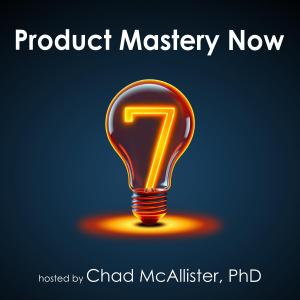Product Mastery Now for Product Managers, Leaders, and Innovators

TEI 328: Getting started with Jobs-to-be-Done – with INDUSTRY and Mike Belsito
A framework for product managers to dig deep into their customers’ needs
I am changing the name of the podcast to Product Mastery Now. The new name is coming soon. You don’t need to do anything to keep listening, but it will show in your podcast player not as The Everyday Innovator™ but as Product Mastery Now. The logo will look the same—just the name is changing.
This episode has two of my favorite things. First, our guest is discussing how he got started with Jobs-to-be-Done and how you can use this valuable tool yourself. Second, he is also the co-founder of Product Collective and the co-organizer of INDUSTRY, the conference for software product managers.
INDUSTRY has a virtual conference coming up on April 20 and 21 and it is worth checking out by going to IndustryConference.com.
Our guest is Mike Belsito. Before his current work, he had a number of product roles and experiences, giving him insights that can help us.
Summary of some concepts discussed for product managers
[10:08] What’s an example of Jobs-to-be-Done?
Jobs-to-be-Done is a framework for understanding how and why people choose products. For example, in my hometown of Lakewood, we have a restaurant called Angelo’s, which is a neighborhood pizzeria, and a Little Caesar’s, which is fast food pizza. If I’m rushing home from my son’s soccer practice and need to be home and eating dinner in ten minutes, I grab a pizza from Little Caesar’s. If friends are visiting, I take them to Angelo’s because I want to show them Lakewood’s personality. I’m not choosing a pizza based on the toppings or ingredients. It’s all about the context and the circumstances. In the language of Jobs-to-be-Done, I’m not “hiring” the pizza to complete the job of feeding me. I’m choosing convenience or entertaining my friends.
[18:39] What are the elements of Jobs-to-be-Done?
* Struggling moment—a moment of pain or need, when we wish there were a better way. As Bob Moesta, a pioneer of JTBD, says, the struggling moment is the basis of innovation.
* Push—realizing there has to be a better way and deciding we’re not going to live with the current solution anymore. We’re pushed to find a new solution.
* Pull—when we become aware of the better way or new solution.
* Anxieties—excuses for why we shouldn’t switch to the new solution.
* Inertia—we stop exploring the new solution because it seems easier to stick with the old solution than to go through all the changes to switch.
[23:59] How do we conduct a Jobs-to-be-Done interview?
A Jobs-to-be-Done interview uncovers all the elements listed above. First, identify whom you’re going to interview. Avoid interviewing outliers; interview average customers or people who aren’t customers yet but have similar problems. Block off two hours for each interview. Spend the first 30 minutes doing a pre-interview; don’t plan out an exact script, but list the important areas you want to explore. Spend a full hour with the customer. Then spend 30 minutes in a post-session, reviewing while the interview is still fresh in your mind.
When you’re interviewing, dig deep. I learned this from Bob Moesta, who helped us interview INDUSTRY customers. One time we were interviewing a customer named Matt and asked, “Why did you buy a ticket to INDUSTRY?” Matt said he wanted to learn from the best. I would have moved on to the next question, but Bob asked, “What do mean by that? Who is the best? What do you mean by ‘learn’?” Bob kept asking questions and digging deeper, and we uncovered valuable insights we otherwise would not have found. Bob told us to act like documentary filmmakers—we’re trying to uncover the...






 Visit Podcast Website
Visit Podcast Website RSS Podcast Feed
RSS Podcast Feed Subscribe
Subscribe
 Add to MyCast
Add to MyCast